【5.2】内含子(II型、I型)
一、内含子介绍
真核基因大多是断裂的:
- 一个基因可由多个内含子和外显子间隔排列而成。
- 内含子在真核基因中所占的比例很高,甚至超过99%。

Exons (外显子): the coding sequences
Introns (内含子) : the intervening sequences
部分人类基因中内含子序列所占的比重分析:

剪接 (Splicing):
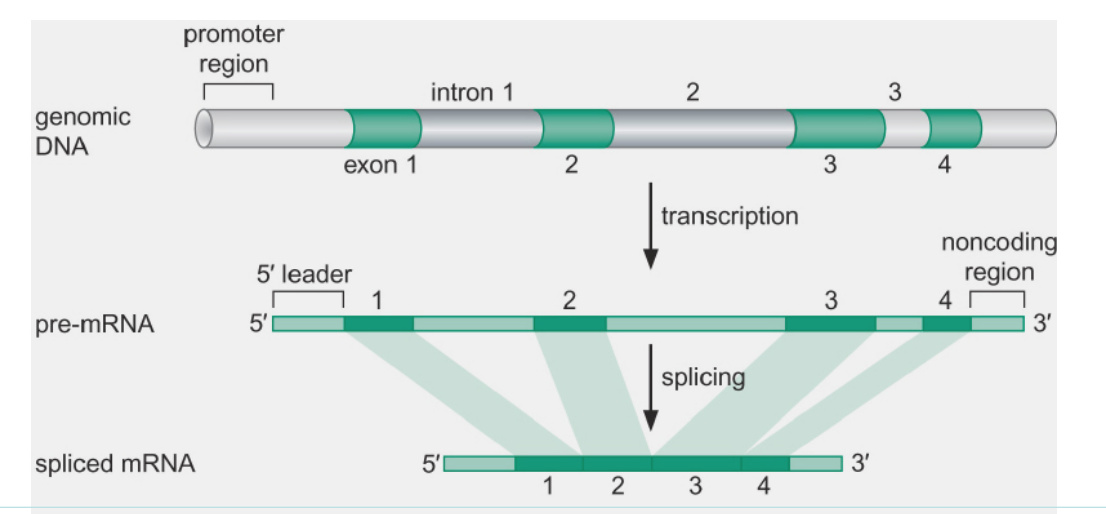
RNA splicing: removal of introns and joining of exons.
- It takes place in the nucleus before the mature mRNAcan be exported to the cytoplasm.
- Catalyzed by spliceosome (RNA +protein)
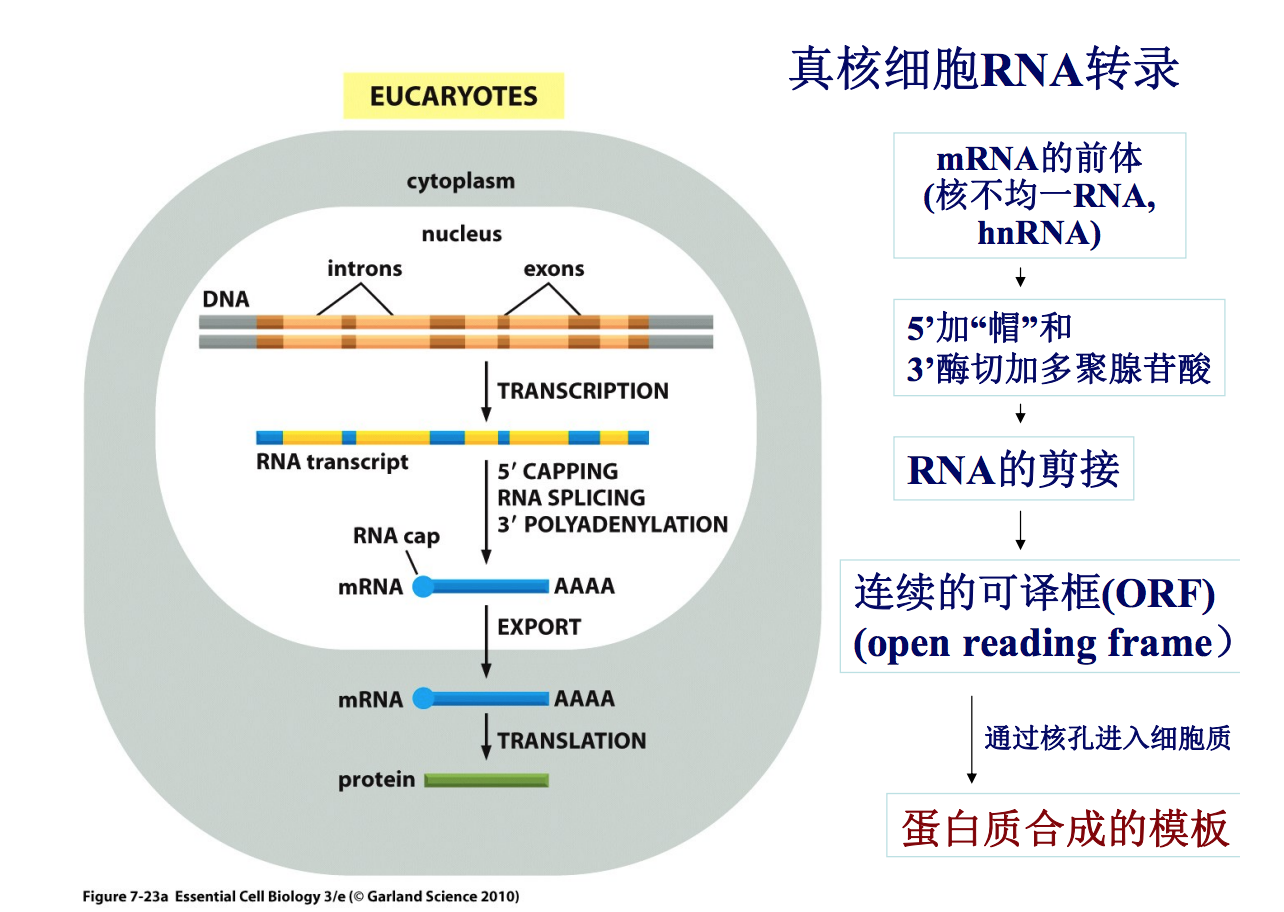
RNA splicing 可通过体外凝胶电泳进行分析
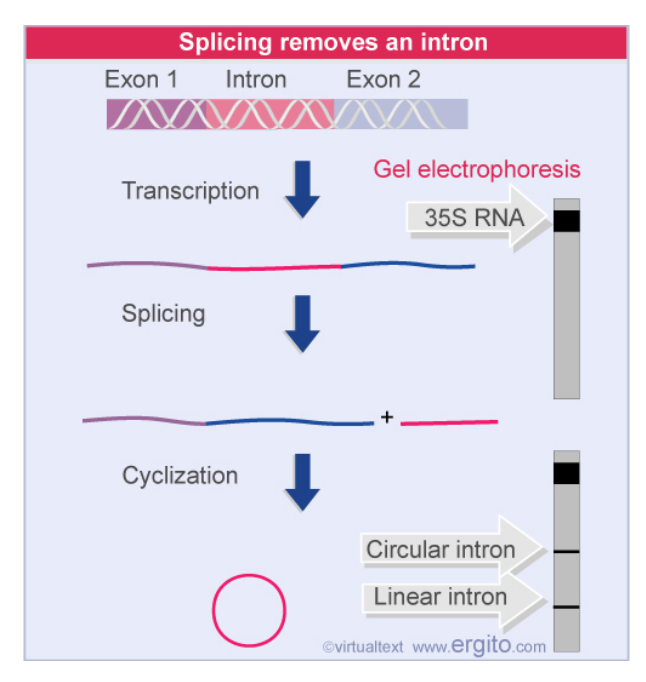
RNA加工过程及其生理功能:

真核基因平均含有8-10个内含子,前体分子一般比成熟mRNA大4-10倍。 内含子的“功能”及其在生物进化中的地位是一个引人注目的问题。
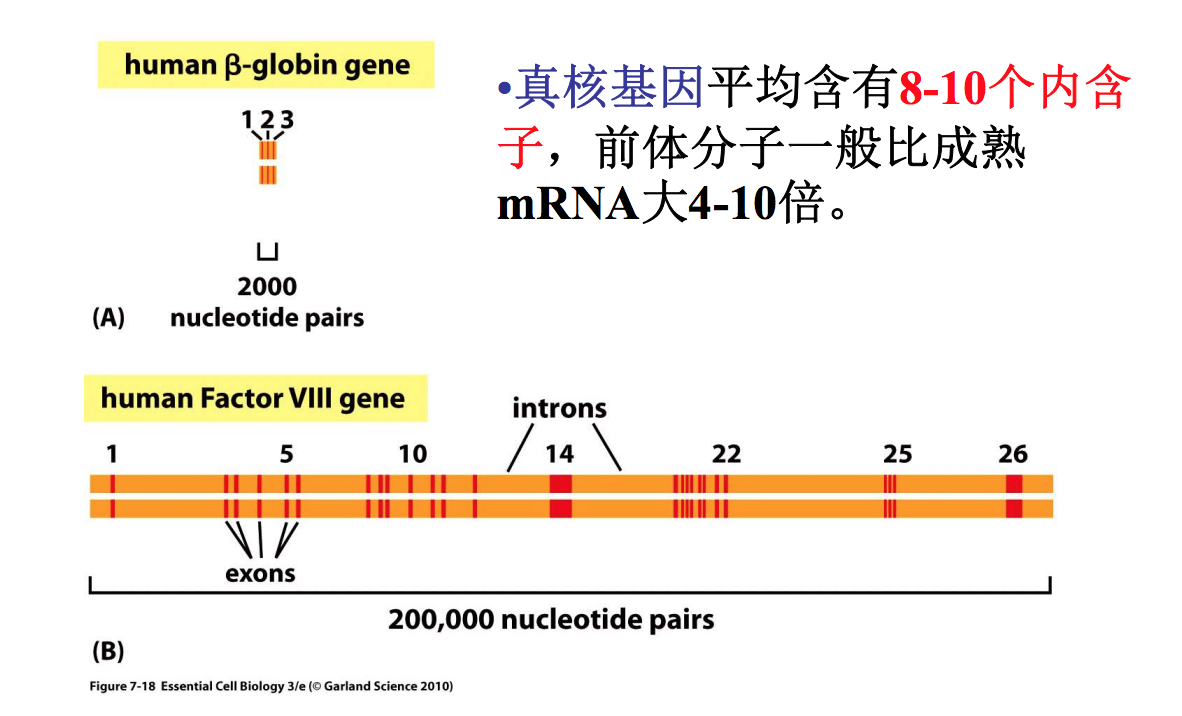
生物体内的各种内含子:
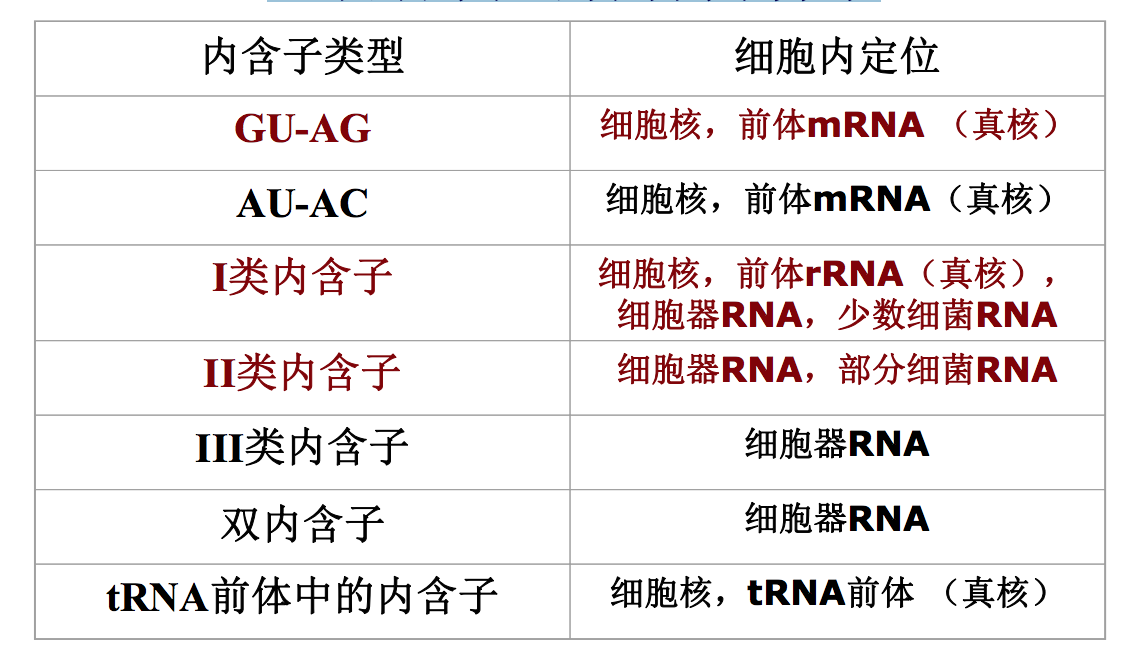
GU-AG或AU-AC分别代表了不同内含子的5’和3’边界序列。
内含子剪接异常引起疾病:
地中海贫血病人的珠蛋白基因中,大约有1/4的核苷酸突变发生在内含子的5’或3’边界保守序列上,或者直接干扰了前体mRNA的正常剪接

二、内含子的剪切
断裂基因发现不久,Crick(1978年)就提出了一系列发人深思的问题:
- 剪切作用若是通过酶来进行的,那么这种剪接酶是怎样识别RNA上特定的位点?
- 剪切酶有没有特异性?对不同的RNA是否需要不同的酶?
- 切除的RNA是以线状还是环状存在的?切下的RNA的命运将如何?
2.1 Chambon法则
Chambon等分析比较了大量结构基因的内含子切割位点,发现有2个特点:
- 内含子的两个末端并不存在同源或互补。
- 连接点具有很短的保守序列,亦称边界序列。100种内含子的5′端都是GU;3′端都是AG,因此称为GU-AG法则(GU-AGrule),又称为Chambon法则。

脊椎动物前体mRNA中常见内含子剪接所必需的保守序列
两个剪接位点的序列是不同的:

- 左边的剪接位点称供体(donor)位点
- 右边的剪接位点称受体(acceptor)位点
GU-AG法则(GU-AG rule)不适用于线粒体、叶绿体的内含子,也不适用于酵母的tRNA基因 。
2.2 核mRNA结构特点
- 边界序列:其边界序列是完全符合GU-AG法则
- 分枝点序列:具有分枝点序列,位于内含子3’端上游18-50nt处,序列为Py80NPy87Pu75APy95,其中A为 百分之百的保守,且具有2’-OH。
- 内含子5′端有一保守序列(5′GUAAGUA3’)可以和U1 snRNA的5’端的保守序列3’CAUUUCAU5’互补。

2.3 核mRNA的剪接
-
转录产生的核内mRNA前体分子与蛋白质结合,形成RNA和蛋白质组成的font color=‘red’>snRNP复合物(ribonucleo-protein protein)。
-
随着RNA链的延伸,每个内含子5’和3’两端的复合物成对联结,产生60S的颗粒—-剪接体(spliceosome),进行RNA前体分子的剪接。
-
细胞核中的小分子RNA称为细胞核小RNA(small nuclear RNA, snRNA);
-
位于细胞质中的称为细胞质小RNA (small cytoplasmicRNA, scRNA)。
-
在自然状态下,它们以核糖核蛋白颗粒(SnRNP和 scRNP)的形式存在,俗称snurps和scyrps。
-
在核仁中也存在着一类小的RNA,称为核仁小RNA (small nucleolar RNA, snoRNA),它们在rRNA的加工中 起作用。
-
snRNA参与剪接过程,并与其它蛋白一起构成一个大的颗粒复合体,称为剪接体(splicesome)
Spliceosome (剪接体):

Three roles of snRNPs in splicing:
- Recognizing the 5’ splice site and the branch site.
- Bringing those sites together.
- Catalyzing (or helping to catalyze) the RNA cleavage.
RNA-RNA, RNA-protein and proteinprotein interactions are all important during splicing.
2.4 真核生物mRNA前体中内含子剪接过程

-
The lariat (套索) is an intermediate in RNA splicing in which a circular structure with a tail is created by a 5 ’ -2 ’ bond.
-
The branch site (分支点) is a short sequence just before the end of an intron at which the lariat intermediate is formed in splicing by joining the 5’ nucleotide of the intron to the 2 ’ position of an Adenosine.

Biochemical steps of pre-mRNA splicing :
- Step 1: a cut is made at the 5′splice site, separating the left exon and the right intron-exon molecule.
- Step 2: cutting at the 3′ splice site releases the free intron in lariat form, while the right exon is ligated (spliced) to the left exon
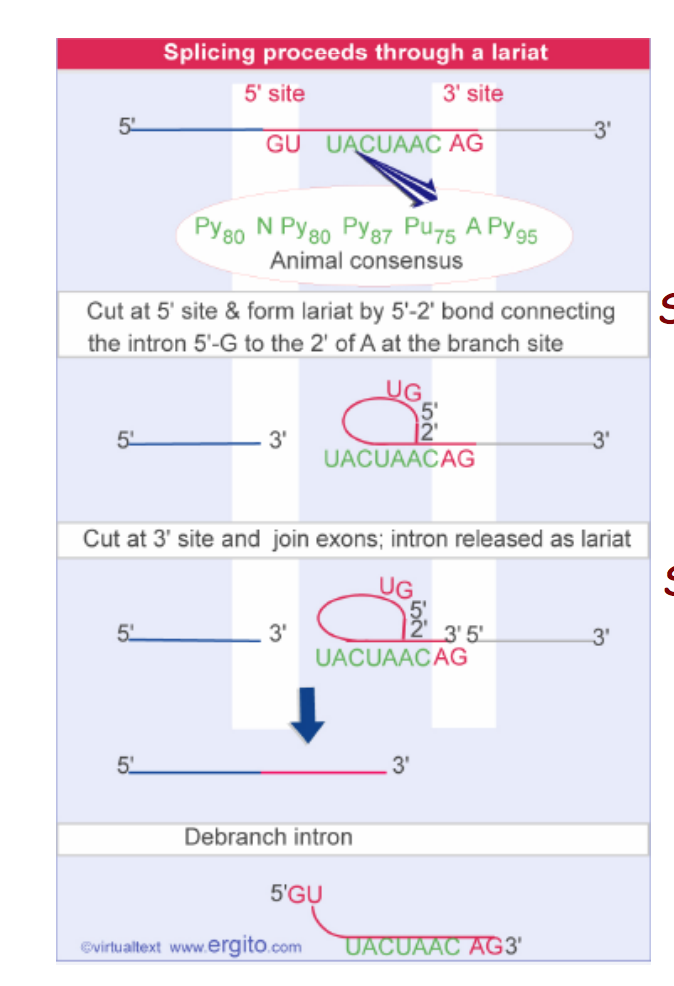

哺乳动物细胞中mRNA前体上的snRNP是从5’向下游“扫描”,选择在分支点富嘧啶区3’下游的第一个AG作为剪 接的3’受点。
AG前一位核苷酸可以影响剪接效率,一般说来, CAG=UAG>AAG>GAG。
如果mRNA前体上同时存在几个AG,可能发生剪接竞争。
三、内含子的变位剪接 Alternative Splicing
-
在高等真核生物个体发育或细胞分化过程中可以有选择性地越过某些外显子或某个剪接点进行变位剪接,产生出组织或发育阶段特异性mRNA。
-
脊椎动物中大约有5%的基因能以这种方式进行剪接,保证各同源蛋白质之间既具有大致相同的结构或功能域,又具有特定的性质差异,进而拓展了基因所携带的遗传信息。
Drosophila DSCAM gene can be spliced in 38,000 alternative ways

Alternative splicing (可变剪接): some pre-mRNAs can be spliced in more than one way, generating alternative mRNAs.
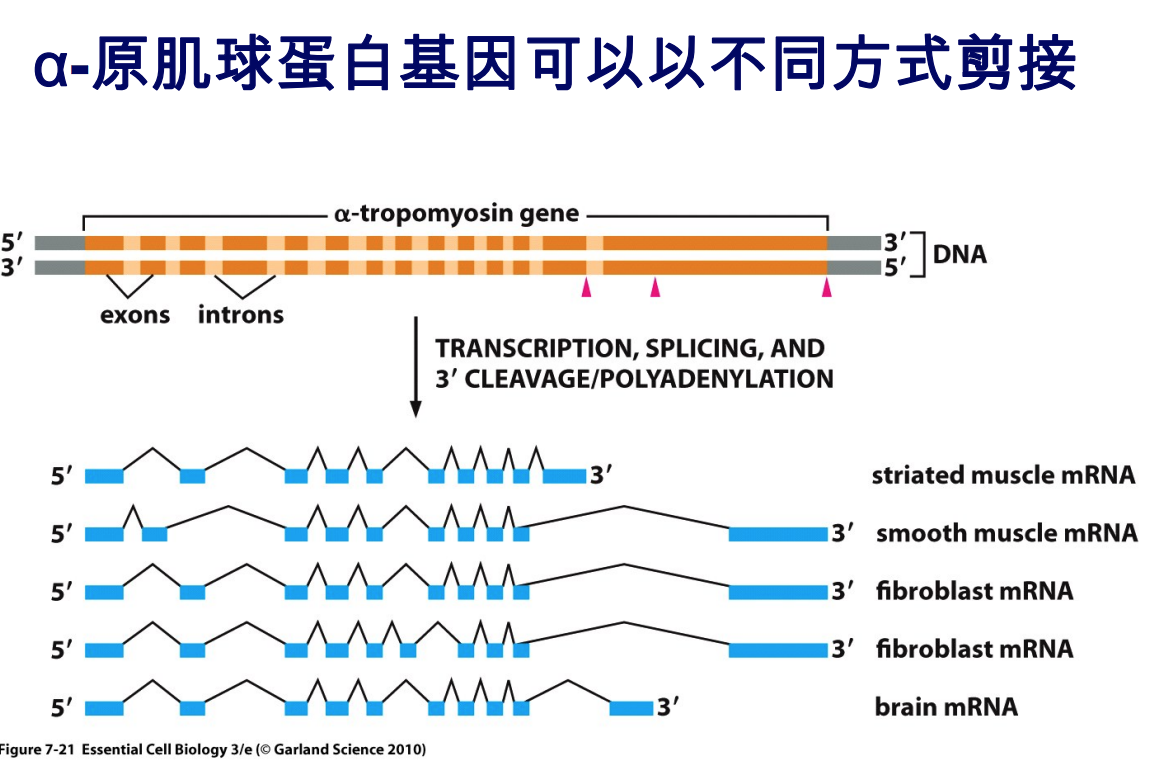
3.1 Different ways of alternative splicing
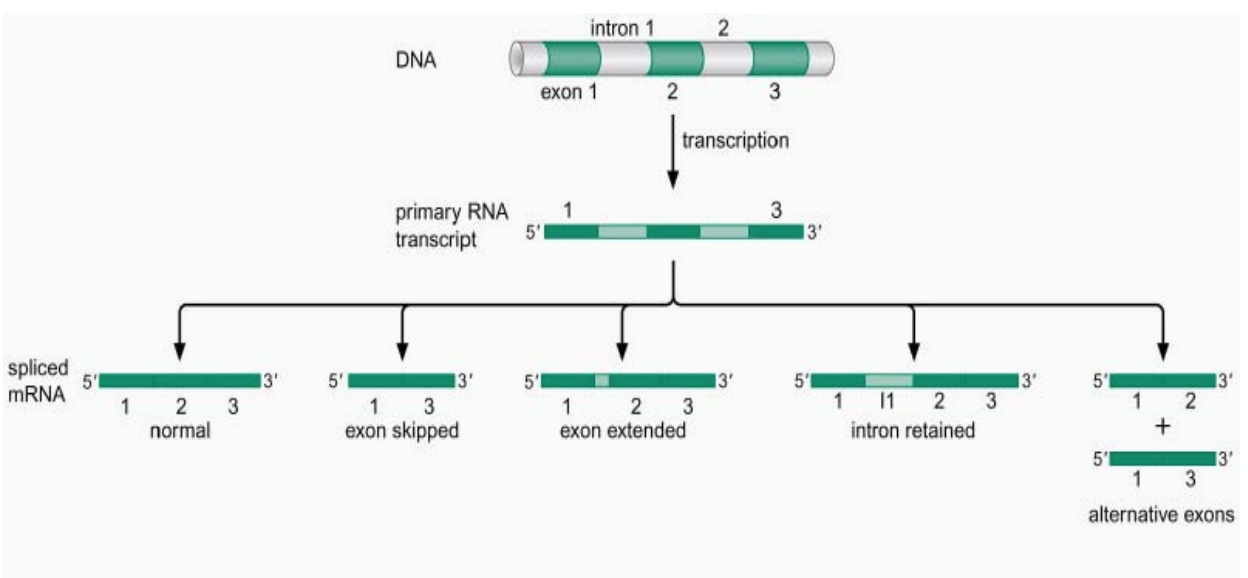
四、Self-splicing introns -I、II类内含子
带有这些内含子的RNA本身具有催化活性,能进行内含子的自我剪接
Autosplicing (Self-splicing,自我剪接) describes the ability of an intron to excise itself from an RNA by a catalytic action that depends only on the sequence of RNA in the intron.

There are two classes of selfsplicing introns:
- group I self-splicing introns
- group II self-splicing introns
4.1 I 类内含子(group I intron)的结构特点
- 其边界序列为5’U-G 3’
- 内含子中具有中部核心结构 (Central core structure that contains a guaninebinding pocket and internal guide sequence)
I 类内含子常分布于低等真核生物的细胞器中,如四膜虫、绒泡菌的rRNA等
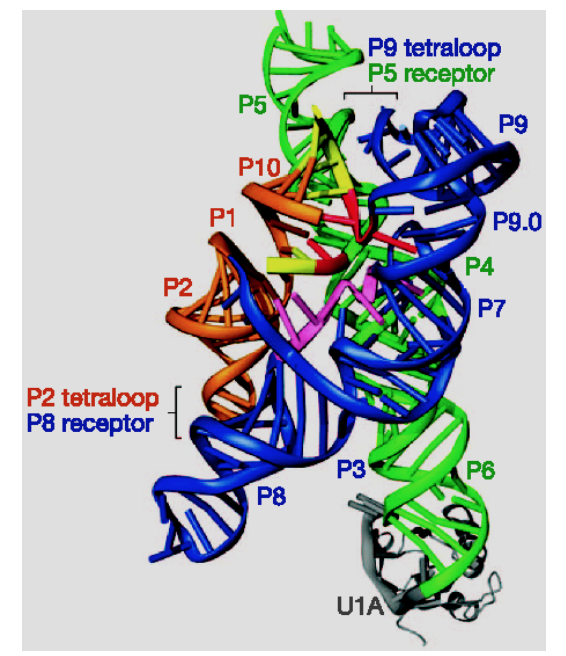
I类内含子的自我剪接过程:
- 自由鸟苷酸的3’-OH作为亲核基团攻击内含子5’端的磷酸二酯键,从上游切开RNA链。
- 上游外显子的自由3’-OH作为亲核基团攻击内含子3’位核苷酸上的磷酸二酯键,使内含子被完全切开。
- 上下游两个外显子通过新的磷酸二酯键相连
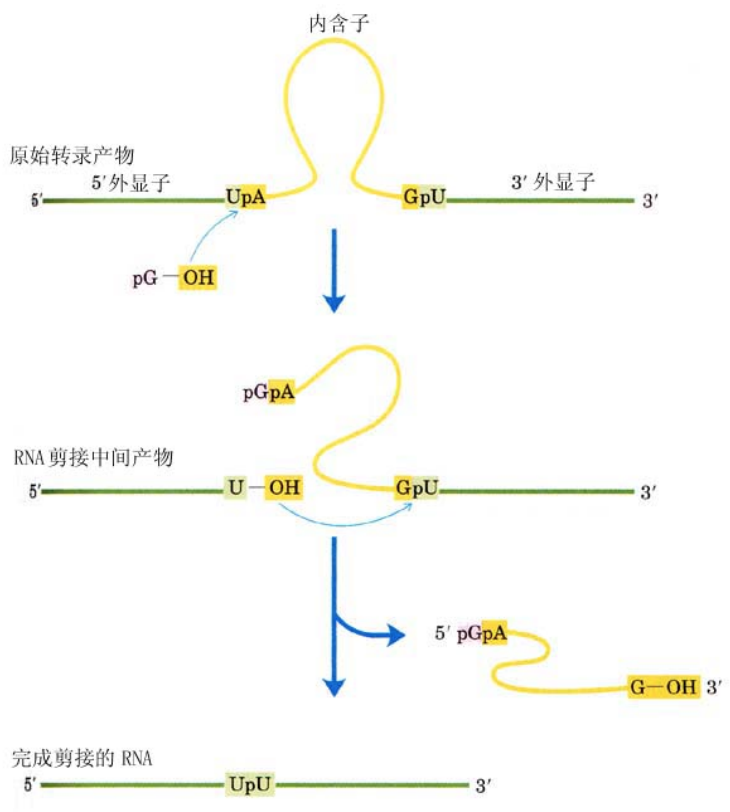
4.2 Ⅱ类内含子(group II intron)
和I类内含子剪接不同;和核mRNA 内含子的剪切有些相似,但也有不同之处。
Ⅱ类内含子分布在:
- 酵母mtRNA,
- 细胞色素氧化酶的α亚基,β亚基,
- 玉米mitochondrial RNA (mtRNA),tRNA
- 真核mRNA前体中
II类内含子的自我剪接过程:
- 分枝点腺苷酸的2’-OH作为亲核基团攻击内含子5’端的磷酸二酯键,内含子5′的边界序列上的G以5′磷酸和分枝点A的2′-OH形成磷酸二酯键,从而产生了套索(lariat)结构。
- 上游外显子的3’-OH作为亲核基团攻击内含子3’位核苷酸上的磷酸二酯键,使套索结构完全解离。
- 上下游两个外显子通过新的磷酸二酯键相连。
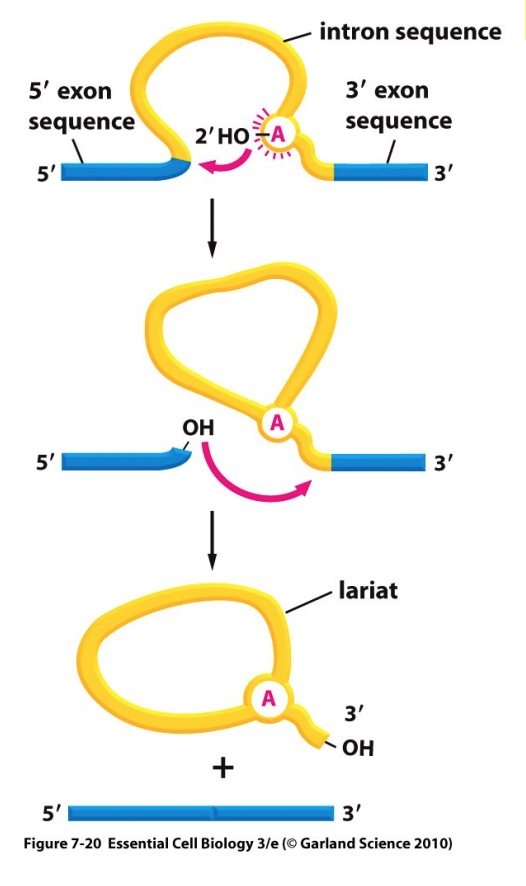
五、几种不同内含子剪接反应的区别
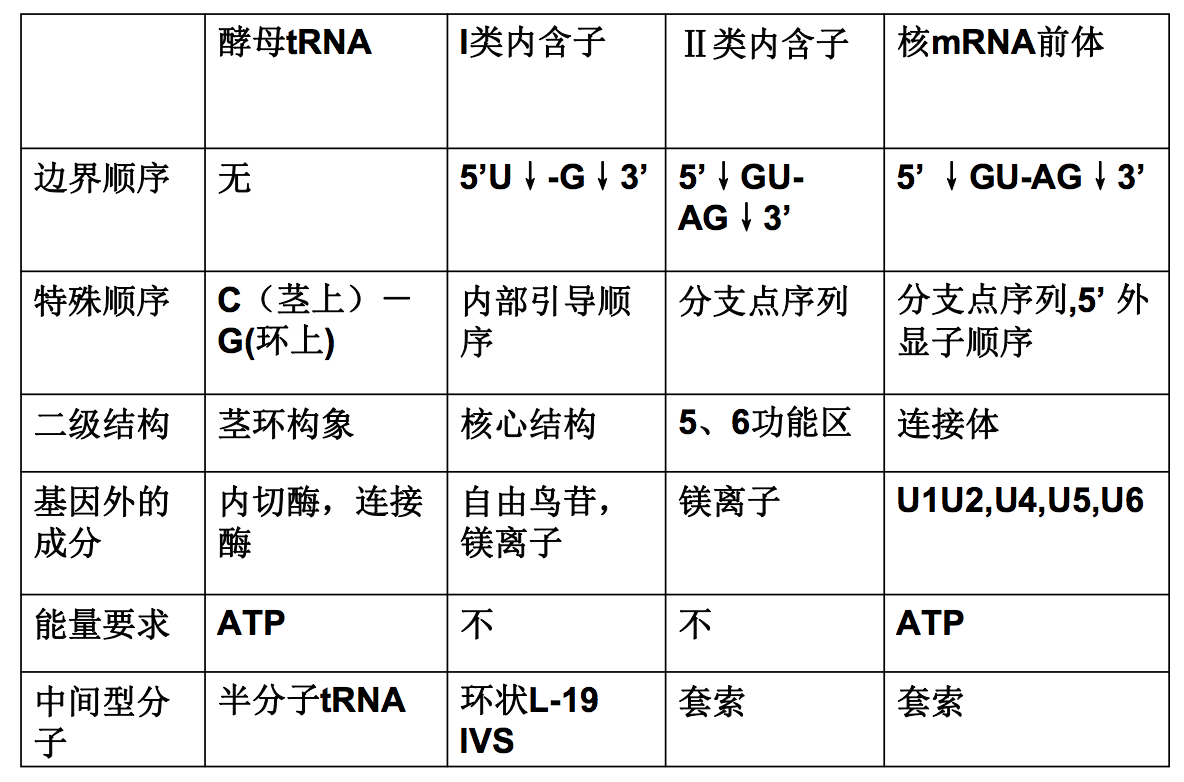
The chemistry of group II intron splicing and RNA intermediates produced are the same as that of the nuclear pre-mRNA
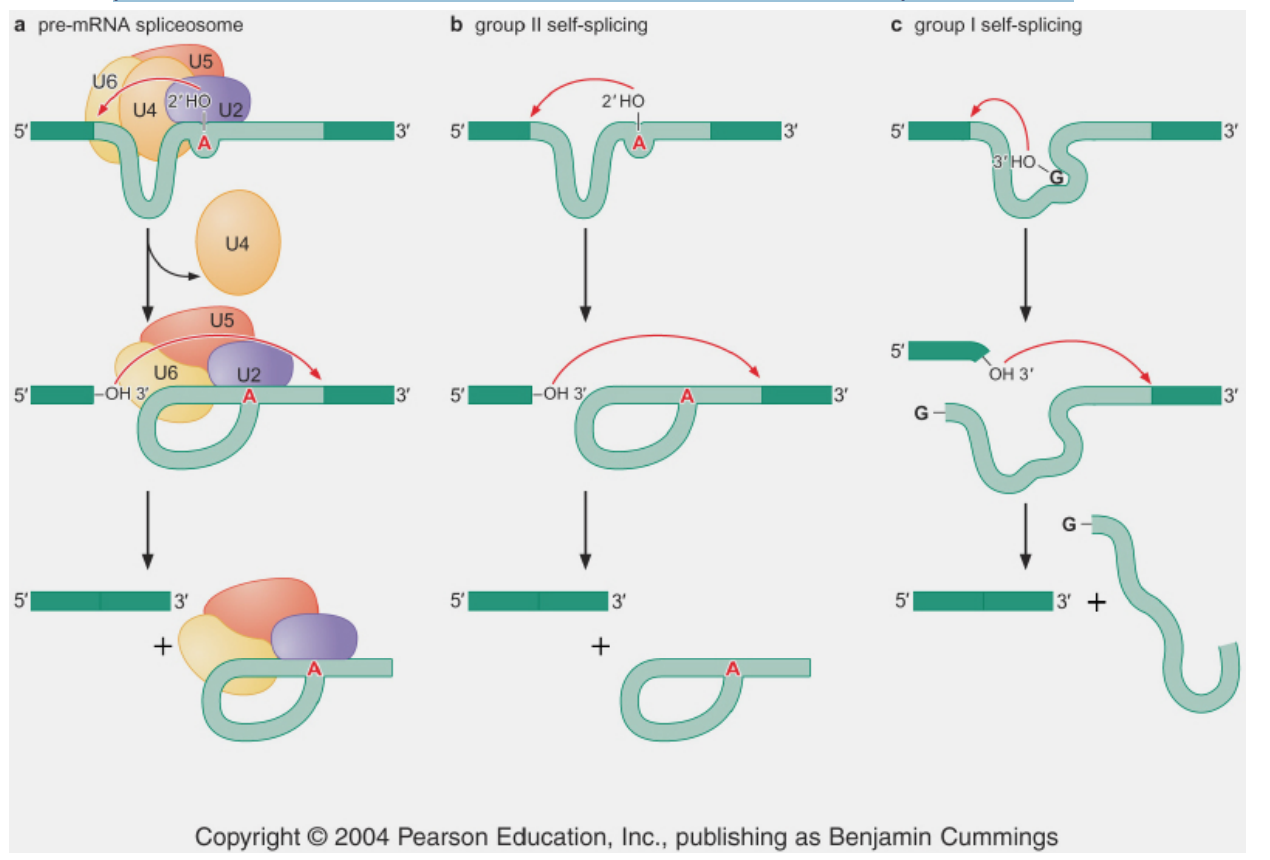
三类剪接反应都是通过两次连续的转酯反应进行的
- 第一次转酯反应中,由一个游离的2’-羟基提供,发动对5’外显子-内含子连接点的攻击。
- 第二次转酯反应中,已经释放的外显子末端的游离3’-羟基接着攻击3’内含子-外显子的连接点。
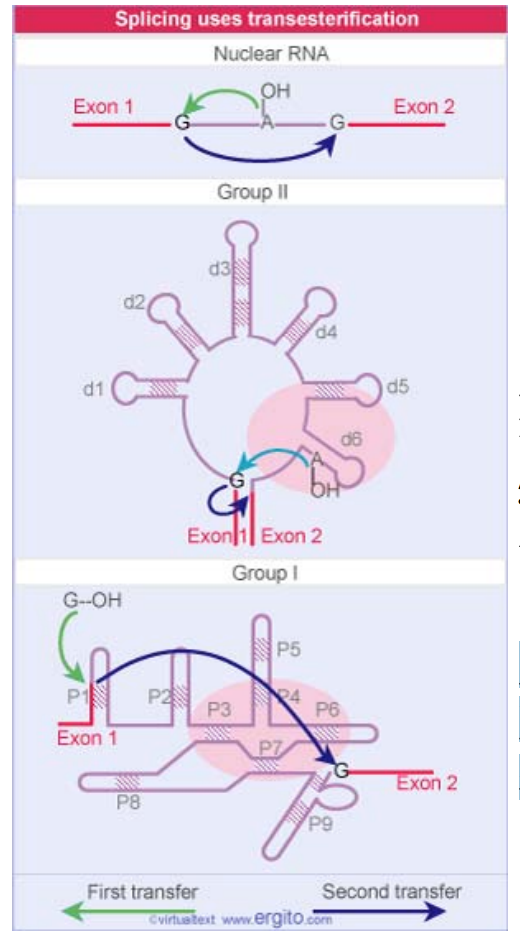
参考资料
